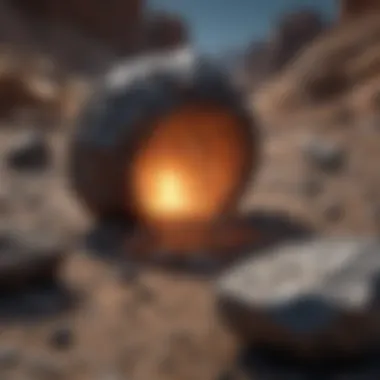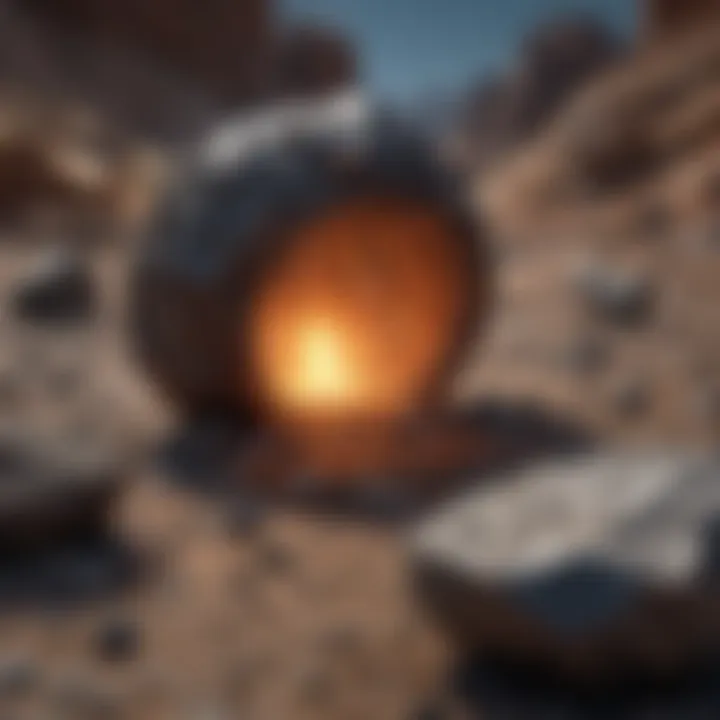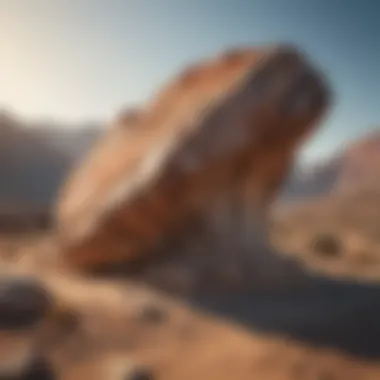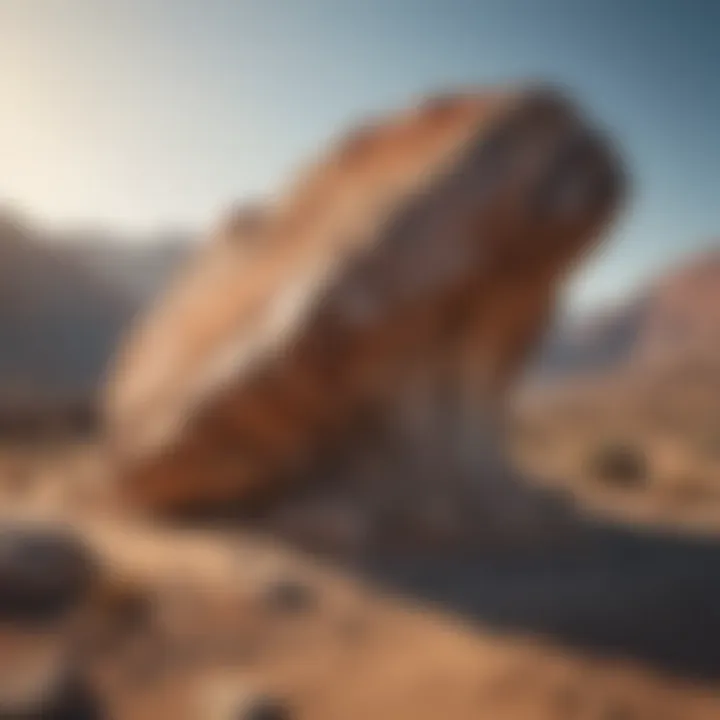Exploring Rock Impact Stones and Their Geological Significance


Intro
The earth we tread upon is a remarkable tapestry woven from billions of years of geological history. Among the silent witnesses to this tale are rock impact stones. Formed through the cataclysmic collisions between celestial objects and our planet, these stones encapsulate stories of ancient cataclysms and gradual transformation.
As collectors and enthusiasts, uncovering the secrets they hold invites a deeper understanding of not just geology, but also Earth’s evolution in the cosmos. Understanding these unique rock formations allows us to appreciate the finer intricacies of natural art and the indelible marks left by events that shaped our world.
In the following sections, we’ll dive into the remarkable characteristics of impactful stones, the intricacies involved in their identification, and the stories behind specific, notable collectible stones that can transport us back in time. Pay close attention; the gems of knowledge presented here might just spark your next expedition into the geological wonders around you.
Prelims to Rock Impact Stones
Rock impact stones provide an intriguing glimpse into Earth's dynamic past. They emerge from celestial events, such as collisions between asteroids or meteorites and our planet's surface. Understanding these rocks is more than just a scientific pursuit; it's a chance to peer into geological processes that have shaped the world we inhabit today.
The study of impact stones is significant for several reasons. First, they serve as natural time capsules, preserving records of specific impact events. By examining these geological markers, scientists can infer the conditions of ancient environments, assess possible catastrophic events, and even predict future impacts. Rock impact stones illuminate the intricate interplay between cosmic events and terrestrial evolution.
Moreover, the allure of collecting these stones adds a layer of personal connection to the broader scientific narrative. Collectors often find themselves drawn not just to the physical beauty of these stones, but also to the stories they carry—stories of violent encounters between our planet and the universe beyond.
"Every rock is like a page in a book of Earth’s history, telling tales of events long past, some catastrophic, some transformative."
As we delve deeper into the nuances of rock impact stones, we will explore how these formations are defined, the mechanisms behind their creation, and their significance in shaping both geological history and contemporary research. Understanding how they fit into the wider tapestry of geological studies enriches our overall comprehension of Earth's evolutionary journey.
Geological Formation Processes
Understanding geological formation processes is pivotal when exploring rock impact stones. It unravels how these stones came to be and what history they encapsulate within their layers. Studying this topic shines a light on various elements, such as impact mechanics, energy transfers, and the differing types of events that give rise to these compelling geological markers. Each impact, whether it originates from an extraterrestrial body or a volcanic eruption, leaves behind symbols etched in stone that tell a story about Earth's history and evolution. When examining these stones, it becomes important to grasp their formation background to better appreciate their significance in our understanding of planetary dynamics and geological time scales.
Impact Mechanics and Energy Transfer
Impact mechanics focuses on how energy is transferred during an impact event. The greater the mass and speed of the impacting body—be it a meteorite or a volcanic explosion—the more energy is transferred upon collision. This transfer of energy leads to physical changes in the rocks, resulting in unique features that are characteristic of impact stones. Just as a pebble skips across calm water and causes ripples, a meteoric impact sends shockwaves through the ground, leading to fracturing and metamorphism of the existing geological structures. Therefore, understanding how this occurs is essential for identifying the type and origin of rock impact stones, as well as learning how these events shape the Earth itself.
Types of Impact Events
The world of impact events is diverse. Each type generates unique stones with specific characteristics. Here, we can explore three principal categories:
Asteroids and Meteorites
Asteroids and meteorites are perhaps the most well-known contributors to impact stones. These celestial bodies, when colliding with Earth, bring their mineral compositions that can greatly differ from local geology. Key characteristic: One primary feature of meteorites is their stony and metallic components, which can sometimes form pseudotachylites under immense heat and pressure during an impact. This attribute makes them a popular choice within this article, as they showcase a vivid example of extraterrestrial influence on our planet. The advantage of studying these stones also lies in their clear relation to space science, revealing insights into the composition of our solar system.
Volcanic Impacts
Volcanic impacts occur through explosive eruptions, often leading to the formation of glassy textures and new minerals emerging from magma. Key characteristic: These stones usually exhibit vesicular or frothy textures, as gases escape during rapid cooling. This unique aspect of volcanic impact stones makes them a fascinating subject of study because they offer insights into the inner workings of the Earth. The advantage of focusing on volcanic impacts is their prevalence and the relatively easy access geologists and collectors have to them.
Human-Made Impacts
Lastly, human-made impacts have become a more prominent area of interest in recent years. These include explosions from quarrying, mining, or military activities that result in notable geological changes. Key characteristic: One significant aspect of human-made impacts is the adoption of technology and industry in creating geologically interesting formations. This makes them a compelling topic in this article, as they reflect human interaction with the earth. On the flip side, while these formations are less ancient than others, studying them can help understand contemporary environmental issues and the lasting effects of human activity on geological formations.
Characteristics of Impact Stones
Understanding the characteristics of impact stones is crucial in unraveling the geological narratives they hold. These stones serve as tangible markers of cosmic events, reflecting both the violent histories of impacts and the transformative forces at play on Earth’s surface. Knowing what to look for when identifying these stones enhances not only scientific study but also collecting experiences for enthusiasts.
Mineral Composition and Textures
The mineral composition of impact stones varies widely, but certain minerals often serve as tell-tale indicators of their origins. Common minerals found in these stones include quartz, feldspar, and various silicates, along with rarer ones like coesite and stishovite, formed under extreme conditions. The texture of these rocks often tells a compelling story as well. For instance, many impactites exhibit a glassy texture resulting from the melting and rapid cooling of materials during an impact event. This glassy substance, known as tektite, can vary significantly in color, ranging from clear to deep green and even black.
The presence of unique textures can indicate not only the pressure and temperature conditions during impact but also the potential processes that shaped the surrounding rocks before, during, and after the impact. Being able to discern these details allows collectors to appreciate the complex histories encapsulated in their specimens.
Identifying Features of Impact Stones
When it comes to identifying impact stones, there are several key features to look for.
Shock Metamorphism
Shock metamorphism is perhaps the most striking aspect of impact stones. It’s the process that involves the alteration of rock due to the high-pressure shock waves generated during an impact event. The seismic energy associated with such events can reshape minerals at a molecular level, creating new forms or causing pre-existing ones to fracture. This characteristic makes shock metamorphic features invaluable when assessing an impact stone's credentials. The main benefit lies in its definitive nature; the changes induced are often irrefutable markers of an impact event.
Unique features stemming from shock metamorphism include the formation of lamellae and unique patterns that are not found in terrestrial processes. However, on the downside, identifying shock features requires careful examination and expertise. Misidentifying these characteristics could lead to misunderstandings in valuation and authenticity.


Breccias and Impactites
Breccias and impactites provide another layer of insight into the fascinating world of impact stones. Breccias typically consist of broken fragments of minerals or rock cemented together, formed under high-energy conditions typical of violent impacts. They can serve as a record of the chaotic environment immediately following an impact event. The primary characteristic of these stones is their mixed composition, which can include both shock-altered materials and unaltered rock, aiding in revealing the event’s history more comprehensively.
Their significance in this article lies in demonstrating the intersection of different geological epochs represented in one specimen. This duality offers collectors a robust narrative to share about each piece they own – each being a window into both destruction and creation. Yet, understanding the complex lineage of breccias and impactites can be tricky and requires a keen eye for detail, as not all are genuine, and some may be products of natural erosion.
Unique Patterns and Striations
Unique patterns and striations formed in impact stones stand out as extraordinary markers of impact events. The sheer force of an impact can lead to the creation of unique grooves, lines, and textures that resonate with stories of their cosmic origins. For avid collectors, spotting these unique features adds an additional layer of excitement and authenticity – each line can be interpreted as a whisper from the past. These markings can also help in differentiating genuine impact stones from terrestrial rocks, lending credibility to their collections.
Such features not only enhance the visual appeal of a specimen but also spark curiosity in exploration and understanding of the science behind it. However, interpreting these patterns accurately demands careful examination and sometimes expert consultation, as they can easily be confused with other geological features.
"Each impact stone tells a story - a chronicle of the forces that shaped it and the history etched into its very essence."
In summary, the characteristics of impact stones are essential tools for both scientific inquiry and personal fascination. The interplay between mineral composition, shock features, and unique patterns create a rich tapestry for understanding our world’s history and the celestial events that have left their mark on it.
Impact Structures on Earth
The study of impact structures on our planet is both fascinating and pivotal for understanding the geological history that shapes Earth today. These structures serve as silent witnesses, encapsulating the high-energy events that have significantly impacted the evolution of our terrestrial environment. Through the examination of these formations, we can glean important insights into not only the dynamics of past impacts but also the broader implications of such events on life and geological processes.
Famous Impact Craters
The Chicxulub Crater
The Chicxulub Crater stands out as a monumental testament to the power of cosmic events. It is located in the Yucatán Peninsula in Mexico and is famously linked to the extinction of the dinosaurs about 66 million years ago. This enormous crater is around 150 kilometers in diameter, making it one of the largest confirmed impact craters on Earth.
What makes the Chicxulub Crater particularly intriguing is its dual characteristic – it is not only an impact site but also a geological archive that reveals critical information about the aftermath of large-scale impact events. The presence of a ringed structure surrounding the crater is a unique feature, showcasing the rebound effect of the Earth's crust after being struck by the asteroid. This rebound resulted in a fascinating geological formation that researchers study to understand the historical climate effects and biological consequences.
In discussions about impact structures, Chicxulub is a beneficial choice because of its extensive research and the wealth of knowledge it has provided. Its link to mass extinction highlights how seriously these events can affect life on Earth. However, the complexity of the surrounding geology also poses challenges in isolating specific effects tied directly to the impact event versus those resulting from other pre-existing conditions.
The Barringer Crater
Often called Meteor Crater, the Barringer Crater is located in Arizona and is regarded as one of the best-preserved impact sites. It's roughly 1.2 kilometers in diameter and about 50,000 years old, with a striking depth that demonstrates the sheer energy released upon impact. Its defining characteristic is the relatively pristine condition it has maintained over millennia.
This crater is beneficial within the context of rock impact studies because it provides a clear example of a smaller-scale but well-documented impact. The surrounding landscape is less altered by geological phenomena, allowing for more straightforward analyses of the impact's effects. The Barringer Crater is not only significant due to its scale but also serves as a laboratory for understanding impact mechanics in action. Still, the relatively young age of the crater could limit its utilization in studies concerning ancient impact structures.
Sudbury Basin
The Sudbury Basin, situated in Ontario, Canada, is an example of an ancient impact structure, around 1.85 billion years old. This basin is approximately 200 kilometers long, making it a giant in the realm of impact geology. What sets the Sudbury Basin apart is its mineral-rich deposits resulting from the impact that created it, which include nickel, copper, and platinum group elements.
The significance of the Sudbury Basin extends beyond just its formation; it illustrates the profound effects an impact can have on mineralogy and resource distribution. Researchers find its unique geological features compelling, offering insights into the long-term effects of large impacts on Earth's crust. However, its vastness can present challenges in terms of localized studies, as the effects radiate out over a substantial area.
"Impact structures are not merely scars on Earth's surface; they are profound indicators of our planet's tumultuous history and hold the key to understanding both past and future geological phenomena."
The Geological Significance of Craters
The geological significance of craters cannot be overstated. They represent more than just impact marks; they act as natural laboratories for accumulating knowledge about Earth’s geological processes, atmospheric conditions, and even the evolution of life. By studying these craters, researchers are able to piece together the events that have shaped the planet, providing a clearer narrative of Earth’s history.
The examination of these structures contributes to practical applications in resource acquisition, hazard assessment, and even planetary defense strategies. In a world increasingly subject to the threat of asteroid impacts, understanding the signs of past impacts could inform future precautions and readiness. In essence, the study of impact structures is a multidisciplinary endeavor with far-reaching consequences.
Studying Rock Impact Stones
Studying rock impact stones is a crucial component in understanding both the processes that shape our planet and the history that these stones reveal. They don't just sit pretty in a collection; they are like time capsules, holding stories of violent impacts that have altered landscapes and ecosystems. Engaging in research on these stones can help uncover insights about not only terrestrial geology but also aspects of planetary science and even astrobiology. The significance of rock impact stones cannot be overstated as they illuminate how collisions with celestial bodies have impacted Earth’s evolution. In this section, we will discuss techniques and interdisciplinary approaches to studying these fascinating specimens.
Techniques Used in Impact Studies
Remote Sensing
Remote sensing has become a key player in the study of impact stones. This technique employs aerial and satellite imagery to analyze geographical features without physical contact. The charm of remote sensing lies in its ability to cover expansive areas quickly, offering insights that might take mountains of physical sampling to achieve. It helps identify potential impact sites by highlighting unusual surface features, such as circular shapes or unexpected geological formations.
However, while this approach is powerful, it does come with a downside. Remote sensing often requires validation through ground truthing, which means that a researcher must physically examine the site eventually to confirm the initial findings. It can be time-consuming, and interpretations may vary based on the quality of imagery used.
Drilling and Core Sampling
Another powerful method used is drilling and core sampling. This technique enables scientists to collect subsurface samples, which can reveal layers of impact stones and their composition. One standout quality of drilling is its precision; researchers can target specific depths to uncover rocks that are otherwise hidden from view. This method essentially brings the deeper geological mysteries right to the lab, opening up a wealth of information for analysis.


That said, drilling can be logistically challenging and costly. The equipment required is specialized, and the process can disrupt the very sediments being studied. If not handled correctly, it may even alter the geological layers, making context and interpretation difficult.
Laboratory Analysis
Laboratory analysis serves as the bedrock of verifiable science, particularly when studying impact stones. Techniques like scanning electron microscopy and X-ray diffraction can characterize mineral compositions with great accuracy. The fine details showcased through these analyses help scientists determine the properties of the impact stones and their origins, effectively piecing together their cosmic puzzle.
A unique feature of laboratory analysis is its ability to provide reproducible results, ensuring that findings can be confirmed by other researchers. However, these analyses often require complex and expensive equipment, as well as substantial expertise. The time taken to analyze samples can also slow down further studies if multiple samples are needed.
Interdisciplinary Approaches
Geology and History
The intersection of geology and history offers a rich terrain for understanding the broader implications of impact studies. Geological events often coincide with historical milestones, influencing human civilization’s trajectory. For instance, the study of impact sites can inform historians about environmental changes that could have affected agriculture or settlement patterns in various cultures.
This joint approach opens a treasure chest of information; it can reveal how ancient communities adapted to sudden shifts caused by geological events. Yet, reliance on historical records can result in gaps where the scientific evidence may not fully align with what’s documented. As such, careful contextualization is critical when merging these two disciplines.
Astrobiology Implications
Impact stones may hold more than just Earth’s history; they could also provide clues to life beyond our planet. This exceptional angle invites a broader discussion about astrobiology. By studying the chemical signatures and organic materials in these stones, scientists can start to piece together the conditions necessary for life to flourish. This is particularly beneficial when considering missions to Mars and other celestial bodies, where impact-related studies could guide explorations.
However, there's a caveat in this endeavor: not every impact stone will bear evidence of life or prebiotic processes. Scientists must approach this line of inquiry with a cautious optimism, understanding that while the potential is substantial, so too are the limitations.
Environmental Studies
Environmental studies shine a light on the ecological consequences of impact events. By examining how impact stones have altered ecosystems, researchers can glean insights into past climate shifts and environmental resilience. This area of study holds relevance today as well, given the growing concern over climate change and natural disasters. Understanding past impacts provides invaluable context as we address modern-day challenges.
The drawback here is that ecological interpretations can involve a great deal of speculation. The environment is incredibly complex, and many factors contribute to ecological changes. Determining the direct impact of a specific stone or event can sometimes be akin to finding a needle in a haystack. Moreover, methodologies can vary widely, leading to different interpretations.
Understanding rock impact stones gives us a layered perspective on Earth's history, bridging knowledge across geology, history, and environmental science.
Studying rock impact stones is so much more than an academic pursuit; it’s about piecing together the larger narrative of our planet's history while potentially informing future actions. By employing various techniques and embracing interdisciplinary methodologies, researchers can unlock secrets that these stones hold, paving the way for an enriched understanding of both Earth’s landscape and the cosmos.
Collecting Impact Stones
Collecting impact stones is an endeavor that appeals to both the scientifically inclined and collectors looking to add unique pieces to their collections. These geological specimens provide a tangible connection to earth's tumultuous past and allow enthusiasts to delve into the mysteries of impact events and their long-lasting consequences on our planet.
Rock impact stones, such as meteorites and other materials shaped by high-energy collisions, carry incredible historical significance. They represent pivotal moments in the history of the Earth and can reveal the environmental conditions that existed long ago. By collecting these stones, individuals not only appreciate their beauty and rarity but also contribute to the greater understanding of geological transformation and planetary interactions.
Ethical Considerations in Collecting
When it comes to collecting rock impact stones, engaging in ethical practices is paramount. A collector should be aware of the implications their collection might have on the environment and cultural heritage.
First and foremost, understanding the legal aspects is crucial. Some locations have specific regulations prohibiting the removal of stones, especially from protected areas. Collectors should always ensure that they're allowed to take with them any specimens from a given site.
Additionally, ethical collecting emphasizes respect for local cultures and indigenous practices. Certain regions may hold spiritual significance for local communities, where the removal of natural resources might carry a deeper impact.
Identifying Authentic Impact Stones
One of the most significant challenges collectors face is verifying that the impact stones they acquire are indeed authentic. This process doesn't solely involve examining the stone but requires a keen understanding of its provenance and features.
Researching Provenance
Researching provenance is the first step in identifying authentic impact stones. Provenance refers to the history of ownership and the source from which the stone originated. Understanding where a stone comes from can clarify many questions about its authenticity.
By investigating the geographical and geological background of a specimen, collectors can discern whether it aligns with known impact sites or events. This aspect of researching provenance makes it a clever choice for serious collectors who wish to bolster their credibility.
A unique feature of examining provenance is that it often involves engaging with geological databases and peer-reviewed studies, providing collectors a more profound insight into their stones. However, it can be time-consuming and not always yield clear answers. But patience pays off when it strengthens the overall value and context of the collections.
Utilizing Expert Resources
Utilizing expert resources is another essential strategy for verifying impact stones. Consulting geology experts or experienced collectors can save time and prevent potential mistakes. Many institutions and universities also offer access to knowledgeable professionals who can help with assessments.
The key characteristic of using expert resources is the invaluable knowledge they provide, which can demystify aspects of impact stones that may seem convoluted to the layperson. Often, experts can identify features that are indicative of genuine impact stones, such as unique shock-induced textures like planar deformation features.
A notable advantage of this approach is the potential for networking within the collector community, creating opportunities for collaboration or attending workshops that can deepen a collector's understanding. Phenomenally, this leads to greater overall enrichment about impact stones.


However, relying solely on expert resources may not always be practical for every collector. It often involves costs, and collectors may need to find local experts, which can be difficult in regions where geology is less popular.
Verifying Authenticity
Lastly, verifying authenticity is the final hurdle in this pursuit. This process typically encompasses several methods ranging from visual inspection to advanced scientific analysis such as isotopic studies.
The essence of verifying authenticity lies in its empirical nature. Collectors can employ proper testing techniques to discern real impact stones from imitations. This approach increases the credibility of a collector's collection and mitigates the chances of fraud.
What adds to the robustness of this method is the increasing accessibility of technology that allows for more straightforward testing. While some methods require specialized equipment or laboratories, others, like simple inspections for specific characteristics, can often be done independently.
Nevertheless, acquiring such tests could be burdensome for the funds of some collectors. Balancing the cost versus the benefit of thorough authentication remains a decision each collector has to make, but the ultimate value of a credible collection often outweighs these concerns.
"For those looking to collect impact stones, remember: authenticity is like a fine wine—it takes time, patience, and often a little expert assistance to truly appreciate its value."
Care and Preservation of Impact Stones
Care and preservation of impact stones are vital aspects that deserve attention from both scientific and collector communities. Every stone, especially those formed from extraordinary events, carries a story painted by time and nature’s unpredictable forces. Just like a fine wine, proper care enhances the value and longevity of these geological artifacts. Weighty decisions circle around how to store, clean, and display these stones, as neglect can tarnish or even damage their unique features. For those who cherish these natural wonders, understanding preservation techniques is not just beneficial, but essential.
Best Practices for Storage
When it comes to storing impact stones, it’s crucial to create an environment that mimics their natural settings as closely as possible. Consider these best practices:
- Temperature Control: Keep stones in a cool, dry place. Temperature fluctuations may result in cracks or harmful changes in the materials.
- Humidity Levels: Excess moisture can lead to mold or degradation. Use silica gel packets or dehumidifiers to maintain optimal humidity levels.
- Use Soft-Bottomed Containers: Choose boxes lined with soft materials like felt or foam. This prevents scratches or breakages during storage.
An organized storage solution also helps in easily locating specific pieces when needed. Labeling each container with details, like the date acquired and its provenance, provides context that can be valuable for future reference.
Cleaning and Maintenance Techniques
Keeping impact stones in pristine condition calls for careful cleaning and maintenance. Here’s how collectors can ensure they remain as attractive as the day they were found:
Safe Cleaning Agents
Cleaning agents utilized for impact stones should prioritize their preservation. Water is often the safest option, particularly when paired with a gentle detergent. Avoid harsh chemicals that can erode the natural surface.
Key Features of Safe Cleaning Agents:
- Gentleness: They protect delicate surfaces from scratching or other damage.
- Biodegradability: Environmentally friendly options reduce pollution, which is an important consideration for collectors who value nature.
Using a safe cleaning agent also brings peace of mind to collectors. With a balanced approach, one can ensure they do not risk damaging the stone while maintaining its aesthetic appeal.
Handling and Display Considerations
Proper handling and display methods can greatly influence the preservation of impact stones. This aspect involves both the physical touch and the way stones are exhibited.
Key Considerations Include:
- Handling with Care: Always wash hands before touching stones to eliminate oils or dirt that can harm their surface. Consider using cotton gloves.
- Avoid Direct Sunlight: Displaying stones in direct sunlight can fade colors and compromise their integrity over time.
These factors combine to create an aesthetically pleasing and educational experience. By taking care of impact stones, collectors not only honor the natural history of these artifacts but also create a legacy of preservation for future enthusiasts.
"Taking proper care of your impact stones is akin to preserving a piece of history; it’s about honoring what nature has crafted over millions of years."
Finale: The Legacy of Rock Impact Stones
Rock impact stones are more than just remnants of celestial events; they are chapters in the story of Earth itself. Throughout this article, we have explored their formation, characteristics, and significance, ultimately highlighting their invaluable role in understanding our planet's history. Knowing how these stones form, whether through asteroid impacts or human-made events, gives us a clearer picture of Earth's evolving landscape.
Impact on Earth's Evolution
Rock impact stones have left an indelible mark on Earth’s evolution. When an asteroid or meteorite strikes our planet, it can have profound effects that ripple through time. These events can lead to mass extinctions, such as what is believed to have caused the demise of the dinosaurs through the Chicxulub Crater impact. This specific incident not only changed biological life but also altered atmospheric conditions and geological formations.
Moreover, impact events can influence the mineralogy of rocks. Preserved impact stones often showcase unique textures resulting from the high-pressure conditions caused by such collisions. Shock metamorphism—a process linked directly to these impacts—causes distinct changes in mineral structures, producing materials that can only be formed under certain circumstances. Thus, rock impact stones provide valuable insights into both the past dynamics of our planet and its ongoing geological processes.
The Future of Impact Studies
As we look toward the future, the study of impact stones continues to hold significant promise. Researchers are now employing advanced technologies, such as remote sensing and drone surveys, to locate and analyze previously undiscovered impact sites. The intersection of geology with other disciplines such as astrobiology offers thrilling possibilities. For example, understanding the implications of impact events on other celestial bodies can help scientists assess their potential for supporting life.
Additionally, as awareness grows within the rock and fossil collecting community, collectors can play a role in these studies. Bringing careful attention to provenance and ethical collecting enhancements can lead to a robust dataset that contributes to scientific research. Collectors are encouraged to engage with experts, attend workshops, and participate in community discussions often found on forums like Reddit or Facebook. This not only helps validate the authenticity of pieces in their collections but creates a strong linkage between amateur enthusiasts and the scientific community.
"The stones we collect from ancient impacts are not just rocks; they are fragments of the cosmos, telling tales that span billions of years."
In summation, rock impact stones are essential to piecing together Earth’s intricate past and will continue to be pivotal in demonstrating the interconnectedness of geological events. As enthusiasm grows for these unique specimens, so too will the approaches to study and conservation, ensuring their legacy endures for generations to come.



